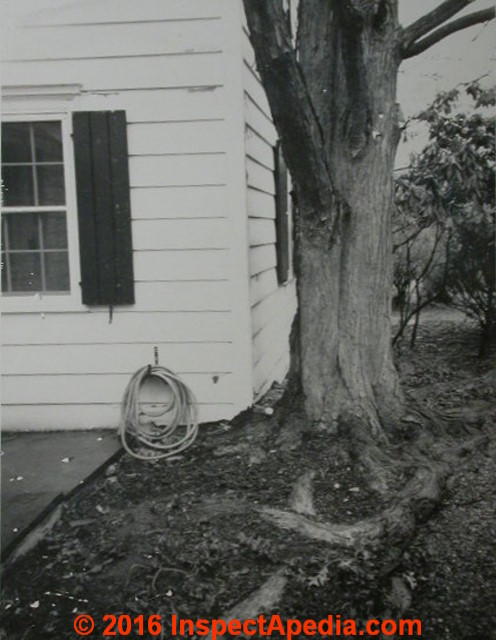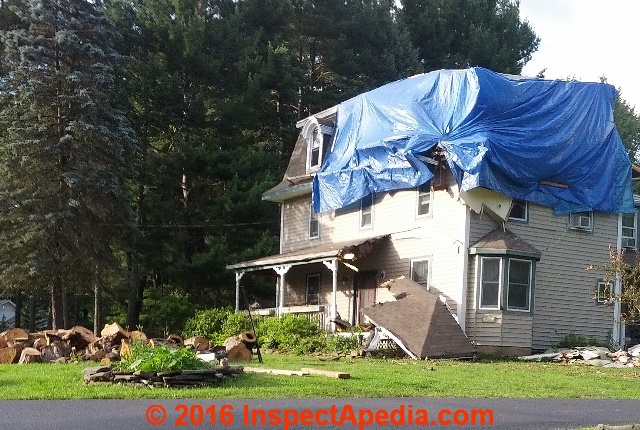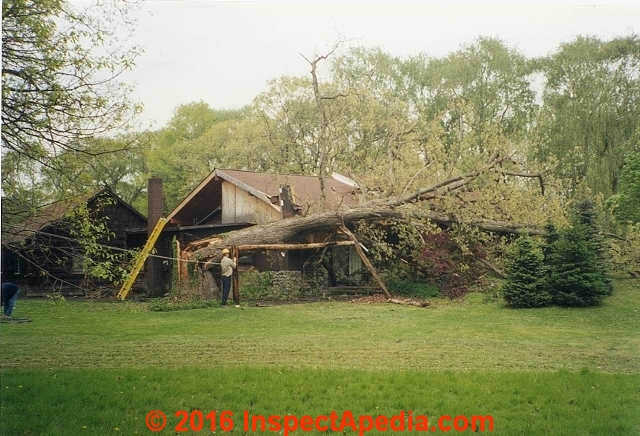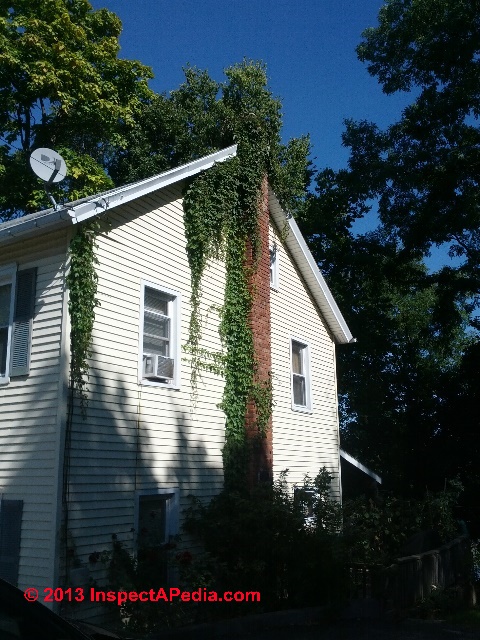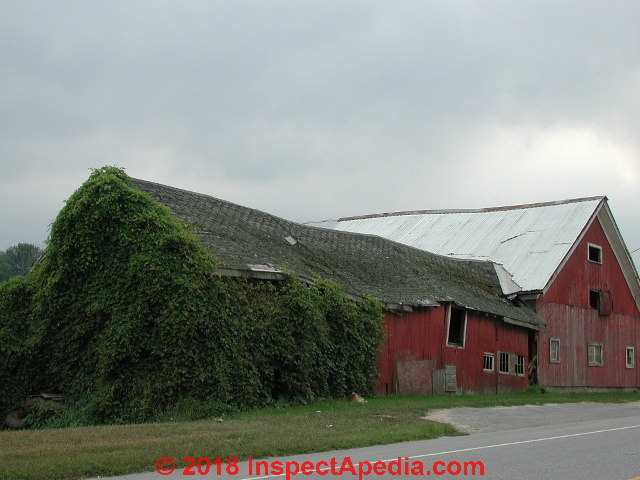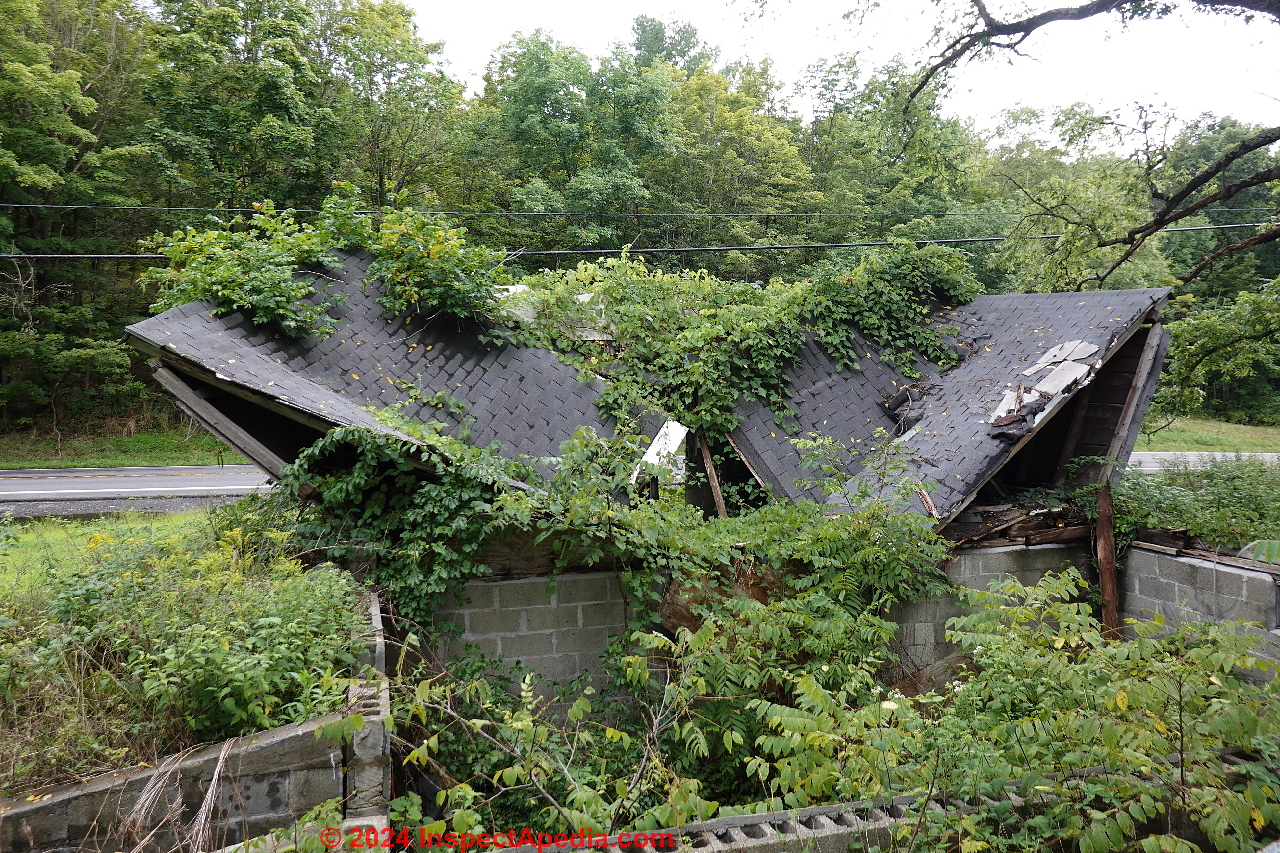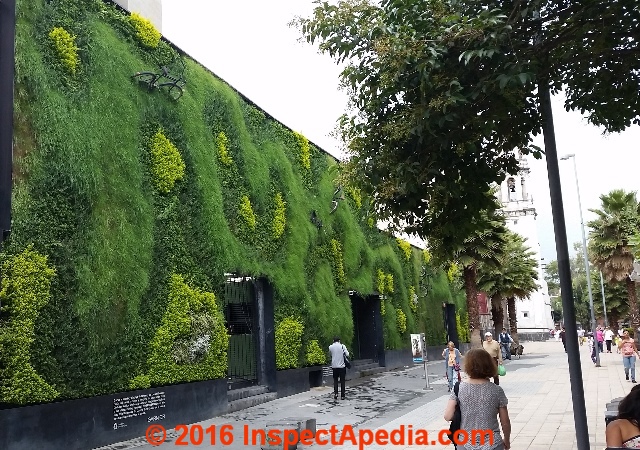 Shrubs, Trees, & Vines on Buildings
Shrubs, Trees, & Vines on Buildings
Risk costly damage, and possible safety concerns
to Structure & to Chimneys
- POST a QUESTION or COMMENT about shrubs, trees, vines growing on or too close to buildings and the risk involved
This article discusses the risks of shrubs, trees, and vines that are growing on or too close to buildings:
Vines on building walls & chimneys create risks of termites, carpenter ants, fires, and even fatal carbon monoxide poisoning of building occupants.
Vines, shrubs, trees too close to building walls also contribute to mold, algae, and rot problems on the building exterior.
We discusses the importance of keeping trees, shrubs, and vines trimmed away from building walls, both to prevent termite or other insect damage and to avoid algae and mold growth on building surfaces.
This article series provides information about wood destroying insect damage, termites, carpenter ants, mold, algae, building wall, exterior trim, or even structural damage invited by heavy vegetation on or close to the building. Even though we find centuries-old buildings with ivy-covered walls, these risks remain a concern.
Page top photo: vines, grass, and even a bicycle decorate the wall of this building in Mexico City.
InspectAPedia tolerates no conflicts of interest. We have no relationship with advertisers, products, or services discussed at this website.
- Daniel Friedman, Publisher/Editor/Author - See WHO ARE WE?
Shrubs, Trees, Vines on Walls, Foundations, Chimneys & Termite or Structural Damage Risk
 It is important to keep trees, shrubs, and vines trimmed away from building walls, both to prevent termite or other insect damage and to avoid algae and mold growth on building surfaces.
It is important to keep trees, shrubs, and vines trimmed away from building walls, both to prevent termite or other insect damage and to avoid algae and mold growth on building surfaces.
That's because vines growing on building walls, even on walls of solid masonry buildings built of stone, brick, or concrete block, provide a covered passage that makes it easier for termites, carpenter ants or other insects or pests to attack the building.
The humidity and shade afforded by trees and shrubs close to walls increases moisture levels on the building wall and invite algae or mold problems on those surfaces.
See STAINS on STONE, STUCCO DIAGNOSE & CURE for more about the formation of algae, fungus, lichens or moss on building surfaces.
Above: ancient wisteria covers the walls of this home in Brooklyn, New York.
Article Contents
- WHEN to REMOVE TREES CLOSE to a BUILDING
- WHEN & HOW to REMOVE VINES on BUILDING WALLS / CHIMNEYS
- RESEARCH & PROCEDURES on VINE REMOVAL & RELATED INSECT DAMAGE
...
Large Trees Close to Buildings: Pros & Cons
Shade from trees close to a building may be desirable for cooling comfort, but that same shade may encourage moss or algae or lichens growth on building roofs and on walls.
Below: the author (DF) cut down this huge beloved maple because of the combination of roof damage and recurrent carpenter ant infestations in the home's lower roofs.
Below: it's apparent that tree shade explains the moss and lichens growth pattern on the roof of the Jacob's Inn just off of the A40 in the parish of Wolvercote, on the edge of Port Meadow, near Oxford in the U.K.
Trees that are too close to buildings may cause foundation damage as tree roots grow against the structure, and in some cases, root structures also increase the risk of crawl space or basement water entry as roots can provide water transport passages through the soil around the building.
In the black-and-white photo by the author taken in March of 1989, the roots of this tree had damaged the building foundation.
The siding at ground level and in-slope grade added to the risk of rot and insect damage at this house wall.
Other risks of trees close to a building, even if far enough away to avoid foundation damage include the risk of a tree falling onto the structure, or the encouragement of lightning strikes at the building.
Above, a tree fell onto and knocked down part of the porch of this home in Dutchess County, New York.
Below, a wonderful old oak fell onto and damaged this Poughkeepsie, New York home.
Really? I am not arguing that all trees near homes need to be cut down, but the health of these trees should be examined from time to time and sick trees at risk of collapse in a storm should be trimmed or cut down as should trees that are damaging the structure through root growth.
Also see TREES & SHRUBS, TRIM OFF BUILDING
...
How to & When to Remove Vines from Building Walls & Chimneys
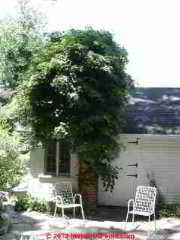 Reader Question: What are best practices to remove an invasive climbing vine and repair an exterior residential wall (condo building). The exterior wall is painted white and is composed of a thin stucco like layer, over cement layer over soft red brick wall.
Reader Question: What are best practices to remove an invasive climbing vine and repair an exterior residential wall (condo building). The exterior wall is painted white and is composed of a thin stucco like layer, over cement layer over soft red brick wall.
The condo building is a cement iron rebar reinforced columns and floors with the walls filled in by brick.
There is no insulation externally or on the interior.
There is no vapor barrier or moisture wrapping or wood material. Environmentally, the condo is in a very humid tropical weather like zone with a heavy rainy season during the summer (Now through OCTOBER) and dry season during winter through spring.
The climbing vine (locally called moneda d' oro- unsure of spelling) roots have infiltrated, through the cement and red brick to the interior wall on some condos.
Water infiltration is a problem on the interior of some condo apartments and deterioration of the wall is evident.
Previous attempts from property management only resulted in infrequent pulling off the vines of the wall up to 4 stories. The vines grow back and the damage to the wall is never repaired.
Now there is water infiltration and roots that have penetrated the stucco like thin covering over soft red brick. It rains every day now as we are in the rainy season and one condo owner wants to pursue removing the vines and repairing the exterior wall now.
The contractor proposes pulling off the vines and wash wall down with muriatic acid then repairs brick mortar where necessary and apply cement coating and then a thin layer of stucco-like coating and paint white.
Considering the use of muriatic acid, and pulling off the growth, my concern is there are roots within the walls (bricks) where pulling out the vines may cause more unnecessary damage as oppose to burning with a torch.
Or, will muriatic acid be sufficient to remove the thin woody roots embedded in walls?
Did I mention that we have a subterranean termite issue although not seen on this wall visually. Any advice to properly remediate this situation for good with a proactive maintenance plan will be appreciated at your earliest convenience.
And with this being rainy season raining everyday is this the time to act? 2016/07/20 Arthur
Where Do Vines have to be Physically Removed from Wall & Chimney Surfaces?
Arthur,
The vines have to be physically removed from the wall surfaces. Inevitably that means that some damage to the wall surface will be found, including
- spots left on the wall surface from the vine's sucker feet or points of adhesion
- paint or coating pulled-off of the wall surfaces when the vine is pulled away
- possibly carpenter ant or termite damage to building walls and wall structures
Your contractor's repair procedure is a common one; the contractor wants to avoid using pressure washing which is likely to damage the masonry wall before it fully removes all vine particles, and may be afraid to use a torch for fire-safety reasons; the torch approach, even if safe in some areas (it's not safe around wood trim, etc), still leaves charred material adhered to the walls.
I suggest thorough physical cleaning, washing to remove muriatic acid from the building surfaces, inspection for remaining roots or branches in mortar joints or other openings, removing those by hand as needed, then re-pointing or tuck pointing the wall with matching mortar where needed.
See STONE, STUCCO & BRICK CLEANING METHODS for cleaning suggestions for problem areas, and for a discussion of the cause, cure, and prevention of algae and mold growth on building surfaces.
Above: dense wisteria or other vines on the outer walls at the Church Farm, St. Weonards, Herefordshire, U.K. - by the author.
Really? Well not always. In some climates, including the building shown just above, masonry buildings have survived for more than 100 years while hosting ivy or similar plants on their surfaces.
On at least some masonry buildings, particularly brick, vines on the building can spell trouble, and some agencies such as US GSA recommend their removal.
It is important to remove heavy vegetative growth from masonry, as its presence can pose many problems, such as holding moisture against the masonry surface, blocking gutters and downspouts, scouring soft wall surfaces, eroding mortar and hindering or limiting access for maintenance inspections and repairs. (U.S. GSA - 2018)
Our experience and OPINION is that vines tend to harbor or cause less damage to stone masonry buildings than to masonry structures made of brick, and both classes of vine-covered buildings may suffer insect invasion at risk points such as wood framed windows and doors.
You may need to dig or pull out the vine roots or to use an herbicide where the vines have been growing.
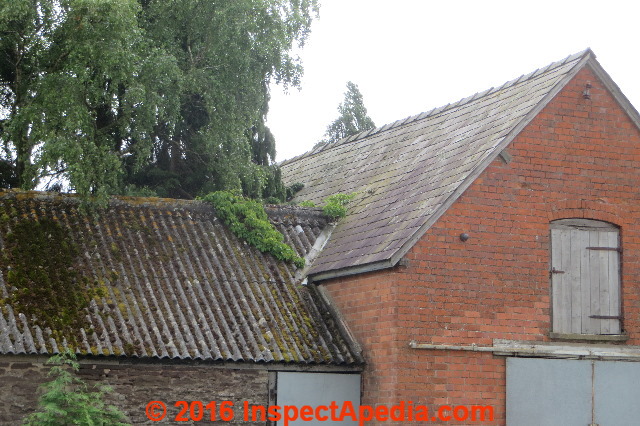 Photo: dense tree and vine growth along a moss and lichens covered corrugated cement-asbestos roof, Herefordshire, U.K.
Photo: dense tree and vine growth along a moss and lichens covered corrugated cement-asbestos roof, Herefordshire, U.K.
These conditions invite insect attack to wood components in the building.
Watch out: Keep in mind that all of these chemicals are potentially dangerous and toxic and must be applied following instructions from the manufacturer for both worker safety and later for occupant safety.
When the walls are cleaned and sealed against leaks, regular inspection for new vine growth should be enough to find and remove unwanted growths before they begin to cover the walls.
Watch out: vines covering chimneys present a fire hazard and a potentially fatal CO hazard if the flues are blocked.
The hazards of vine-overgrown chimneys are discussed in detail
at CHIMNEY INSPECTION from GROUND.
Watch out: vines covering building walls are an engraved invitation to termites and carpenter ants to attack the building, as they give a covered passage up foundation walls or masonry walls to openings that permit access to wood framing or trim.
So after all of your de-vining, it makes sense to have two more inspections as discussed below and added work if it's indicated:
Examples of Vines Growing on Wood Buildings - Inviting Trouble
Above: vines covering walls and part of the roof of this antique barn in New Canaan, Connecticut make an inspection for pest damage impossible from outside the building. A closer look from the interior is likely to find a combination of rot and insect damage to this building.
Below: Vines have completely overgrown this now-collapsed 1940s home in Craryville, New York - photographed by the author in August 2024.
and
More about this building collapse is
at ROOF BENDING, SAGGING, COLLAPSE
So what should be done if we intend to preserve a building overgrown by vines? Particularly if it's a wood structure we should:
- Inspect for active termite or other wood destroying insect activity
on or in the building, paying special attention to wood structural components near ground level as well as for higher wood components that were given access by the vines. Treat as needed.
See TERMITE DAMAGE INSPECTION - Inspect for impact on the structure:
structural damage, should your pest inspector find evidence that termites or carpenter ants or other wood destroying insects (WDI) have been in the building.
See STRUCTURAL DAMAGE PROBING - Address the building water entry problem properly.
I'd be surprised if vine roots were themselves sufficient to cause a building water entry problem.
Most often the water problem originates with defects in gutters, downspouts, or surface grading and runoff. Keep in mind that in addition to the invitation that vines on walls offer to termites, wet conditions in and around the building can also increase the risk of insect attack on the structure.
See WATER ENTRY in BUILDINGS - home - for a detailed how-to guide.
and WET BASEMENT PREVENTION
...
Research: Rot, Mold, Insect Damage, Leaks and Water Entry in Buildings
- Cox, Caroline, Protecting Your Home from Subterranean Termite Damage [PDF] Journal of Pesticide Reform, Fall 2004, V 24 No. 3, - 6-7, Northwest Coalition for Alternatives to Pesticides/NCAP, POB 1393, Eugene OR, 97440 541-344-5044 www.pesticide.org: Web search 09/11/2010: http://www.hipspro.com/pubs/subterraneantermites.pdf
This document discusses alternatives for termite protection including reducing the attractiveness of the structure to termites (get wood away from the building, fix leaks), use of 16-grit sand (diameter 0.06 - 0.1 in) as a termite barrier 18" wide x 3" deep in crawl areas, or stainless steel mesh for the same purpose under foundations and slabs, boric acid, Diflubenzuron (insect growth regulator, risk genetic damage, EPA classed as carcinogen), Hexaflumuron (insect growth regulator,
EPA didn't ID health concerns, waived some testing, partly because of anticipated very low risk of human exposure), Hydramethylnon (stomach toxicant, EPA: Carcinogen, highly toxic to fish), Noviflumuron (chemically similar to hexaflumuron), can cause anemia, EPA didn't ID other health hazards, some testing requirements waived, moderately toxic to fish). - Day, Karen E., RESTORING VINE COVERAGE to HISTORIC BUILDINGS [PDF] Site Preservation No. 1, U.S. Department of Interior, National Park Service, Preservation Assistance Division, retrieved 2022/10/07, original source: https://www.nps.gov/tps/how-to-preserve/tech-notes/Tech-Notes-Site01.pdf
Excerpt:
Vines can damage historic clapboard or masonry buildings in a number of ways.
Roots growing near buildings retain moisture and can put pressure on foundations, displacing materials and providing entry points for water, insects, and rodents.
The primary damage caused by all vines is due to moisture. The shade created by extensive vegetation cover prevents the sun from drying the covered wall, and also reduces the drying effect from air circulation.
Moisture from condensation, rain water, and plant transpiration is thus slow to evaporate and creates an environment conducive to paint failure , wood rot, and deterioration of soft masonry.
The continuous presence of moisture on masonry buildings can weaken mortar and cause structural deterioration. When water trapped in cracks and openings freezes, the ice expands- pressure that can further damage the masonry. In addition, vines cause other fonns of damage depending on their individual growth habits.
Twining vines climb by sending out shoots that wrap around objects and grow in both length and width. As the vine grows thicker, it can constrict these objects, causing features such as louver shutters to snap under the increasing pressure.
Furthermore, the spreading shoots penetrate openings and crevices. In time, the growing vine can loosen and separate building materials. Like twining vines, tendril vines wrap around objects for support.
Because they are actually extended leaves, tendrils do not grow in width, only in length. Both twining and tendril vines, however, can break weather seals on wooden facades, separating wood shingles and siding, as well as fascia and soffit boards on porches.
Other vine types include Aerial vines which grow small roots along the length of the stem. These rootlets cling to the wall and can force their way into crevices.
The fineness and density of the rootlets makes removal difficult. Creeping vines have tiny adhesive pads that cling to the building surface.
Commonly found on masonry brick buildings, creeping vines do not generally cause extensive damage to structures while growing, although they may abrade softer mortar.
However, they attach themselves so thoroughly to the building surface that paint, mortar, and brick are likely to be damaged when the vines are removed. - EPA, U.S., TERMITES - GREENHOUSE GASES, [PDF] U.S. EPA, Environmental Protection Agency. Web search 09/11/2010, original source: http://www.epa.gov/ttn/chief/ap42/ch14/final/c14s02.pdf Quoting an interesting passage from this brief document:
Termites inhabit many different ecological regions, but they are concentrated primarily in tropical grasslands and forests. Symbiotic micro-organisms in the digestive tracts of termites (flagellate protozoa in lower termites and bacteria in higher termites) produce methane (CH4).
Estimates of the contribution to the global budget of CH4 from termites vary widely, from negligible up to 15 percent. - Fuchs, Thomas W., DESERT TERMITES, [PDF] Thomas W. Fuchs, Extension Entomologist, Darrell N. Ueckert, Texas Agricultural Experiment Station, and Bastiaan M. Drees, Extension Entomologist, Texas Agricultural Extension Service, Texas A&M University System, web search 09/13/2010, original source: http://insects.tamu.edu/extension/bulletins/uc/uc-016.html
- PESTICIDES CONTAMINATE HOUSE [PDF] - news article about improperly applied pesticide chemicals and building contamination
- Termites, Wikipedia web search 09/11/2010, original source: http://en.wikipedia.org/wiki/Termite provided some information about termite size.
- U.S. GSA REMOVING CLIMBING PLANTS AND CREEPERS FROM MASONRY [PDF] (2018) U.S. General Services Administration, retrieved 2020/12/14
Excerpt:
This procedure includes guidance on removing climbing plants from masonry.
It is important to remove heavy vegetative growth from masonry, as its presence can pose many problems, such as holding moisture against the masonry surface, blocking gutters and downspouts, scouring soft wall surfaces, eroding mortar and hindering or limiting access for maintenance inspections and repairs. - U.S. GSA REMOVING BIOLOGICAL GROWTH FROM EXTERIOR MASONRY AND STUCCO [PDF] (2018) U.S. General Services Administration, retrieved 2020/12/14
Excerpt: This procedure includes guidance on removing biological growth such as lichens, algae, mold and mildew from masonry and stucco. B. Biological growths such as lichens, algae, moss and fungi growing on masonry walls is usually an indication that there is excess moisture in or around the masonry.
These growths should be removed, as they attract moisture to the masonry surface and hold it there, which can lead to more serious problems. Lichens and mosses in particular, produce oxalic acid which can damage certain types of historic masonry.
...
Reader Comments, Questions & Answers About The Article Above
Below you will find questions and answers previously posted on this page at its page bottom reader comment box.
Reader Q&A - also see RECOMMENDED ARTICLES & FAQs
Reader Comment: concern for pests invited in by vines
Pest infestation can cause serious damage. Termites can destroy the foundation and walls of your home.
Other pests like ants, cockroaches, mice and rats are dirty and uncomfortable, and can cause damage. Pest control services let you keep on top of the problem by providing preventative maintenance for a reasonable cost.
They usually have a spring and fall control cycle where they come and spray the outside foundation to create a barrier against pests entering your home. - (Sept 21, 2016) Arthur Conley
Reply by (mod) - thanks for the opinion, Arthur; we've kept it here as generally correct advice but without your advertisement for pest control services. - Daniel
...
Continue reading at TERMITE DAMAGE INSPECTION or select a topic from the closely-related articles below, or see the complete ARTICLE INDEX.
Or see these
Recommended Articles
- PESTICIDE EXPOSURE HAZARDS
- STAIN DIAGNOSIS on BUILDING EXTERIORS
- STAINS on BRICK SURFACES
- STONE, STUCCO & BRICK CLEANING METHODS
- TERMITE SIGNS INDOORS
- TREES & SHRUBS, TRIM OFF BUILDING
Suggested citation for this web page
VINES & SHRUBS on BUILDING WALLS, CHIMNEYS at InspectApedia.com - online encyclopedia of building & environmental inspection, testing, diagnosis, repair, & problem prevention advice.
Or see this
INDEX to RELATED ARTICLES: ARTICLE INDEX to INSECT DAMAGE
Or use the SEARCH BOX found below to Ask a Question or Search InspectApedia
Ask a Question or Search InspectApedia
Try the search box just below, or if you prefer, post a question or comment in the Comments box below and we will respond promptly.
Citations & References
In addition to any citations in the article above, a full list is available on request.
- Best Practices Guide to Residential Construction, by Steven Bliss. John Wiley & Sons, 2006. ISBN-10: 0471648361, ISBN-13: 978-0471648369, Hardcover: 320 pages, available from Amazon.com and also Wiley.com. See our book review of this publication.
- David Grudzinski, Advantage Home Inspections, ASHI cert # 249089, HUD cert# H-145, is a professional home inspector who contributes on various topics including structural matters. Mr. Grudzinski, Cranston RI serving both Rhode Island and Eastern Connecticut can be reached at 401-935-6547 fax- 401-490-0607 or by email to Davidgrudzinski@aol.com. Mr. Grudzinski is a regular contributor to InspectAPedia.com - see DECK FLASHING LEAKS, ROT Case Study, and BASEMENT WATER MOLD IMPACT and VERMICULITE INSULATION for examples.
- U.S. EPA. Prevention, Pesticides, and Toxic Substances. 1997. Re registration eligibility decision: Diflubenzuron. Pp. 17, 46. www.epa.gov/ pesticides.
- U.S. EPA. Office of Prevention, Pesticides and Toxic Substances. 1994. Pesticide fact sheet: Hexaflumuron. Washington, D.C.
- U.S. EPA. Office of Pesticide Programs. 2003.
Pesticide ecotoxicity database. Unpublished database.
U.S. EPA. Prevention, Pesticides, and Toxic Substances. 1998. Re registration eligibility decision: Hydramethylnon. Pp. 16-18, 43. www.epa.gov/pesticides. - U.S. EPA. Prevention, Pesticides and Toxic Substances. Undated. New chemical New chemical fact sheet: Noviflumuron. Washington, D.C.
- In addition to citations & references found in this article, see the research citations given at the end of the related articles found at our suggested
CONTINUE READING or RECOMMENDED ARTICLES.
Search the InspectApedia website
Note: appearance of your Comment below may be delayed: if your comment contains an image, photograph, web link, or text that looks to the software as if it might be a web link, your posting will appear after it has been approved by a moderator. Apologies for the delay.
Only one image can be added per comment but you can post as many comments, and therefore images, as you like.
You will not receive a notification when a response to your question has been posted.
Please bookmark this page to make it easy for you to check back for our response.
IF above you see "Comment Form is loading comments..." then COMMENT BOX - countable.ca / bawkbox.com IS NOT WORKING.
In any case you are welcome to send an email directly to us at InspectApedia.com at editor@inspectApedia.com
We'll reply to you directly. Please help us help you by noting, in your email, the URL of the InspectApedia page where you wanted to comment.
- Carson, Dunlop & Associates Ltd., 120 Carlton Street Suite 407, Toronto ON M5A 4K2. Tel: (416) 964-9415 1-800-268-7070 Email: info@carsondunlop.com. Alan Carson is a past president of ASHI, the American Society of Home Inspectors.
Thanks to Alan Carson and Bob Dunlop, for permission for InspectAPedia to use text excerpts from The HOME REFERENCE BOOK - the Encyclopedia of Homes and to use illustrations from The ILLUSTRATED HOME .
Carson Dunlop Associates provides extensive home inspection education and report writing material. In gratitude we provide links to tsome Carson Dunlop Associates products and services.




